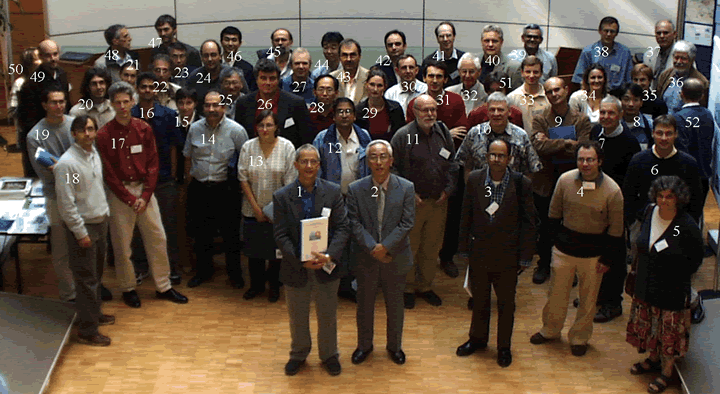- Home
- Events
- Conferences and Workshops
- 2003
- International Workshop on Hard X-ray Photoelectron Spectroscopy
International Workshop on Hard X-ray Photoelectron Spectroscopy
HAXPES Workshop Group Picture

1. J. Zegenhagen, 2.Shigemasa Suga, 3. O.P. Niraula, 4. E. Mesto, 5. D. Chandesris, 6. L. Patthey, 7. S. Hüfner, 8., 9. F. Sette, 10. C. Fadley, 11. L. Braicovich, 12. U. De, 13. E. Fernández Sánchez, 14. G. Castro, 15. E. Narducci, 16. S. Krishnamurthy, 17. S. Thiess, 18. G. Paolicelli , 19. J. Rubio-Zuazo, 20. F. Offi, 21. I. Joumard, 22. G. Panaccione, 23. A. Kotani, 24., 25. K. Kobayashi, 26. J. Woicik, 27. R. Moberg, 28. T.-L. Lee, 29. K. Schulte, 30. B. Cowie, 31. M. Grioni, 32. C. Kunz, 33. O. Tjernberg, 34. C. De Nadaï, 35. M. Gautier-Soyer, 36. D.P. Woodruff, 37., 38. O. Gunnarsson, 39. A. Chainani, 40. C. Janowitz, 41. N. Brookes, 42. P. Bressler, 43. W. Drube, 44. Y. Takata, 45. H. Ebert, 46. K. Shimada, 47. I. Vartaniants, 48. G. Stefani, 49. P. Torelli, 50., 51. C. Dallera, 52.
A total of 62 registered participants and some “observers” gathered on September 11 and 12, 2003 at the ESRF to attend the first international workshop on HArd X-ray PhotoElectron Spectroscopy (HAXPES). Scientist from 11 countries enjoyed 12 invited and 6 contributed talks, presented by an excellent panel of speakers. Stefan Hüfner (University Saarbrücken, Germany), the keynote speaker of the opening session, remarked that this was the first meeting, which he attended on a field that does not exist. Indeed, HAXPES, judging by the literature, is hardly existing with just a few papers published. However, with a large amount of brand-new and unpublished results presented at the meeting, it became quickly obvious that the field is in a state of a very dynamic development, owing to the availability of brilliant x-ray sources. The aim of the technique is to render photoelectron spectroscopy truly bulk sensitive detecting electron with energies up to and beyond 10 keV and an energy resolution down to 10 meV. The major advantages of the HAXPES technique for material science and basic physics research such as an information depth of larger than 10 nm and a resolving power of better than 30000, limited at present only by the available spectrometers, were already demonstrated during this meeting in several contributions. However, the difficulties and challenges such as low cross sections, angular resolution, multipole contributions, and spectrometer design were vividly discussed. The talks were followed by lively and fruitful discussions, which continued during the two poster sessions and the banquet of the evening of the first day. The award for the best poster was given by the jury consisting of Charles Fadley (University of California Davis), Stefan Hüfner, and D. Phil Woodruff (University of Warwick) to Sebastian Thiess, PhD student of the ESRF, for his poster entitled “Hard X-ray Photoelectron Spectroscopy up to 14.5 keV on Au and C and YBa2Cu3O(7-δ) single crystals”. Because of the obvious success of the meeting and the strong activity of Japanese researchers in the field (7 Japanese attendants), Shigemasa Suga (Osaka University) and Keisuke Kobayashi (SPRING8) agreed that the next HAXPES workshop should be organized in Japan.



